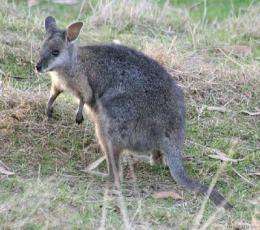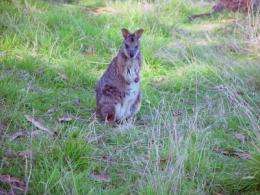The first kangaroo genome sequence

Kangaroos form an important niche in the tree of life, but until now their DNA had never been sequenced. In an article newly published in BioMed Central's open access journal Genome Biology, an international consortium of researchers present the first kangaroo genome sequence – that of the tammar wallaby species – and find hidden in their data the gene that may well be responsible for the kangaroo's characteristic hop.
"The tammar wallaby sequencing project has provided us with many possibilities for understanding how marsupials are so different to us," says Prof Marilyn Renfree of The University of Melbourne. Renfree was one of the lead researchers on the project, which was conducted by an international consortium of scientists from Australia, USA, Japan, England and Germany.
Tammar wallabies have many intriguing biological characteristics. For example, the 12 month gestation includes an 11 month period of suspended animation in the womb. At birth, the young weigh only half a gram, and spend 9 months in the mother's pouch, where the newborn babies reside for protection. Researchers hope that the genome sequence will offer clues as to how tammar wallaby genes regulate these fascinating features of kangaroo life.
In addition to zeroing in on the "hop" genes, other exciting discoveries from the genome include the 1,500 smell detector genes responsible for the tammar wallaby's excellent sense of smell, and genes that make antibiotics in the mother's milk in order to protect kangaroo newborns from E. coli and other harmful bacteria. As Prof Renfree explains, lessons to be learned from the tammar wallaby genome "may well be helpful in producing future treatments for human disease."

The first kangaroo genome is a key milestone in the study of mammalian evolution. As the ancestors of kangaroos separated from other mammals at least 130 million years ago, it is hoped that the DNA sequence is in some senses a living fossil of the early mammalian species from which humans evolved. To understand this evolutionary journey better, the genome sequence is complemented by the "transcriptome" sequence, which represents a catalogue of how strongly each gene is turned "on" or "off" at different stages of the tammar life cycle and in different parts of the body. Study of the transcriptome will allow many more interesting questions to be asked about how kangaroo genes compare to their counterparts in humans.
The Genome Biology article is accompanied by a series of articles in the journals BMC Genomics, EvoDevo, BMC Immunology, BMC Molecular Biology, BMC Genetics, BMC Developmental Biology and BMC Evolutionary Biology, which collectively examine some of the most appealing biological stories arising from the genome sequence.
The tammar wallaby is only the third marsupial, and only the second Australian marsupial (after the Tasmanian devil), to have its genome sequenced. As the kangaroo is an icon of Australia, whose image appears on its coat of arms, currency and national airline symbol, the publication of its genome sequence in Genome Biology stands as a landmark day in Australian science.
More information: Marilyn B Renfree, et al., Genome sequence of an Australian kangaroo, Macropus eugenii, provides insight into the evolution of mammalian reproduction and development, Genome Biology (in press)
Provided by BioMed Central



















